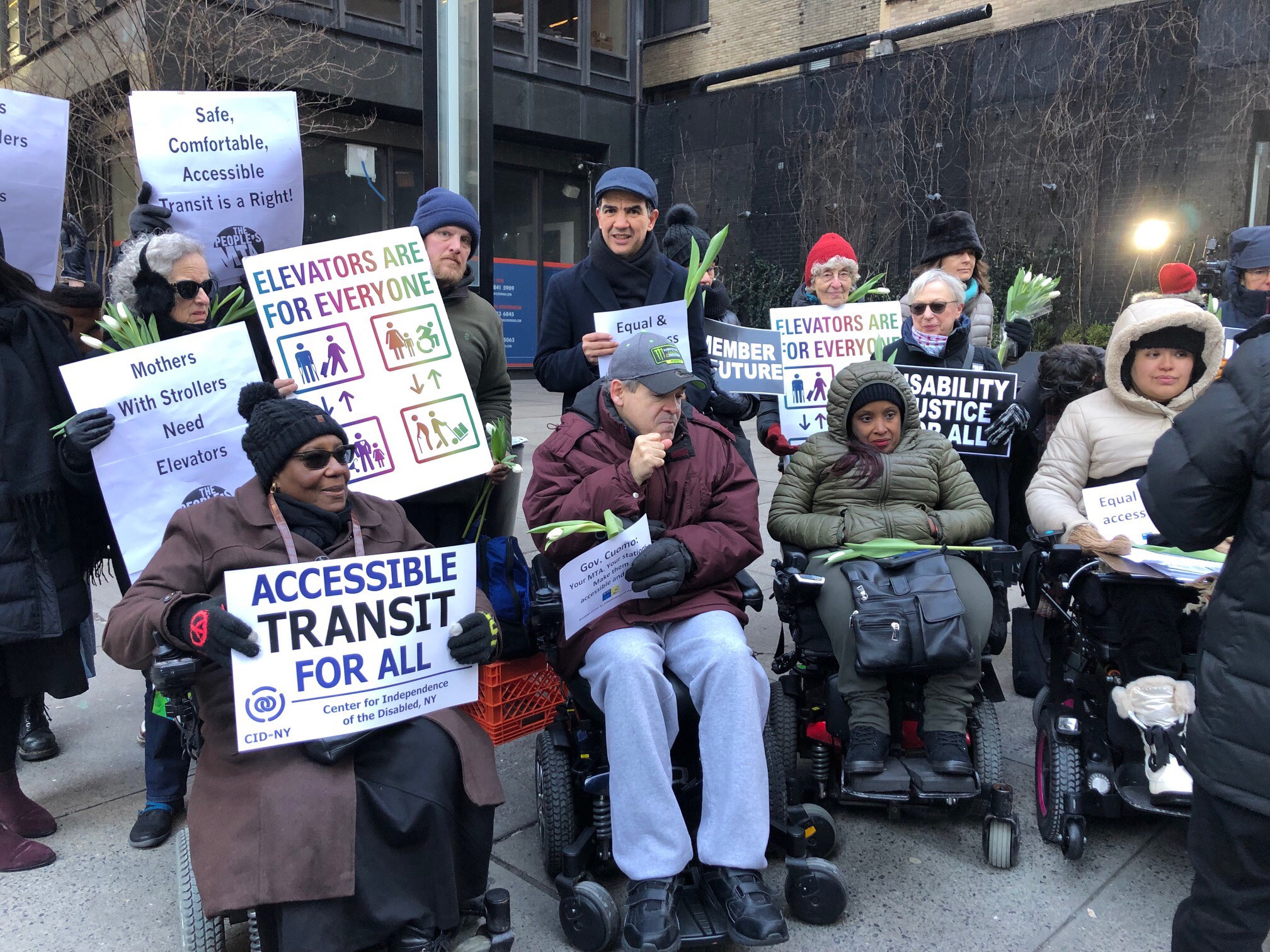

Malaysia Goodson, 22-year-old African-American mother, was carrying a stroller with her 1-year-old daughter, Rylee, down the steps of a New York City subway station on Jan. 28. It had no elevators and two escalators that only go up. Goodson fell down the stairs to her death, somehow protecting her child who survived.
Within 24 hours of the news breaking, leaders in the accessibility rights movement gathered on Jan. 30 at the 53rd Street and 7th Avenue subway stop where Goodson died. As temperatures dropped well below freezing, they demanded elevators throughout the subway system and honored Goodson by laying flowers at the subway entrance where she fell.
An emergency coalition of groups, including the Brooklyn Center for the Independence of the Disabled, the Center for the Independence of the Disabled NY, Rise and Resist, and the People’s MTA, called the action.
The takeaway from the rally’s many speeches was that Goodson’s death was preventable. Speakers called on the MTA to settle the multiple lawsuits against it by committing to a court-enforceable timeline for the installation of elevators in the subway system.
The assembled groups have made this demand multiple times at Metropolitan Transit Authority board meetings and anti-fare-hike protests. Goodson’s death amplified what disability rights leaders have said all along: The demand for accessible subways affects everyone — parents with strollers; elderly riders; both riders with mobility disabilities and many with nonmobility disabilities, such as sight impairment; workers carrying heavy loads; and travelers with luggage. At some point everyone needs an elevator.
‘This could happen to anybody’
Dustin Jones, a disability advocate and plaintiff in a federal lawsuit addressing the MTA’s poor maintenance of elevators, said that as a wheelchair user he has had to rely on strangers many times to carry him or his chair up subway staircases. “Why should anybody have to go through that? Why should a mother, with her baby, have to go down the stairs at any given time, to get anywhere around the city? It’s a travesty. This could happen to me. This could happen to anybody here. Why isn’t the MTA listening to us?”
Though many reporters and camera crews attended the protest and vigil at the subway entrance, the action received scant coverage in comparison to announcements by the city medical examiner and the New York Police Department that Goodson’s fall was due to a “pre-existing medical condition.”
It’s not surprising that the MTA would try to get the city medical examiner as well as the NYPD to run interference for it. Goodson’s death came as the transit authority has possibly the worst reputation ever in its 50-year existence.
Starting with maddeningly dysfunctional operations, massive reductions in service, a history of racist crackdowns on riders who can’t afford the fare, and a criminal lack of elevators, the headlines have only gotten worse since the MTA’s crisis of leadership in January over the L train shutdown.
The upcoming decision to raise transit fares has topped all of that. But the MTA has more than bad publicity to worry about. It is also already facing multiple lawsuits over the lack of transit accessibility.
Amid the already existing mass anger at the MTA, the shocking tragedy of Goodson’s death has elicited more outrage and mass solidarity as the hearts of the people of New York have gone out to her and her family.
Subway stairs: a major hazard
Some 5.5 million people take the subway every day. During the winter, they are trying to navigate dangerous snow- and slush-covered stairs as they travel to work, child care services, job interviews and doctors’ appointments. It is treacherous even without carrying a stroller.
Everyone who has taken the subway for more than a month has either been a parent struggling alone on the steps with a stroller or has seen and/or helped a parent in this hazardous situation. Parents have responded online to this tragedy with their own stories. Much of the massive online commentary has been “That could easily have been me.”
Mothers, especially, relate how dangerous and difficult it is to manage stairs with one child in a stroller and often other children in tow. Some mention that strangers often help carry strollers up stairs, but that assistance can’t be counted on. Some people who want to help are not healthy enough to do so. Women worry if the stranger they ask for help will harass or stalk them.
As of Feb. 4, a gofundme page for Goodson’s funeral had raised more than $10,000; another one for her daughter had raised $20,000.
The city medical examiner’s findings may push back the headlines that followed Goodson’s death, but the outpouring of sympathy can’t be pushed back. The MTA is like one person with a pail trying to bail out of a massive flood.
Fighters for accessibility speak at MTA board meetings and rally in front of courthouses. Yet the journalists who show up to these events often manage to ignore their presence. The mix of street actions and outpouring of solidarity for Goodson have brought the call for subway elevators further into public view – and hopefully further out of media-imposed isolation.
Download the PDF Black and white version All out for May Day! Students defend pro-Palestine…
By Jonas, Mutual Aid Scientific Socialism To the workers and free peoples of the world: We…
Houston Mumia’s supporters gathered in Houston’s historic Emancipation Park on April 27, not just to…
El Partido Mundo Obrero (PMO/WWP) saluda el 50 aniversario de la impresionante victoria de la…
Spain’s Prime Minister Pedro Sanchez cancelled a multimillion-dollar arms deal recently to buy munitions from…
Buenos Aires, April 15, 2025 Katz is an economist, researcher at the National Scientific and…